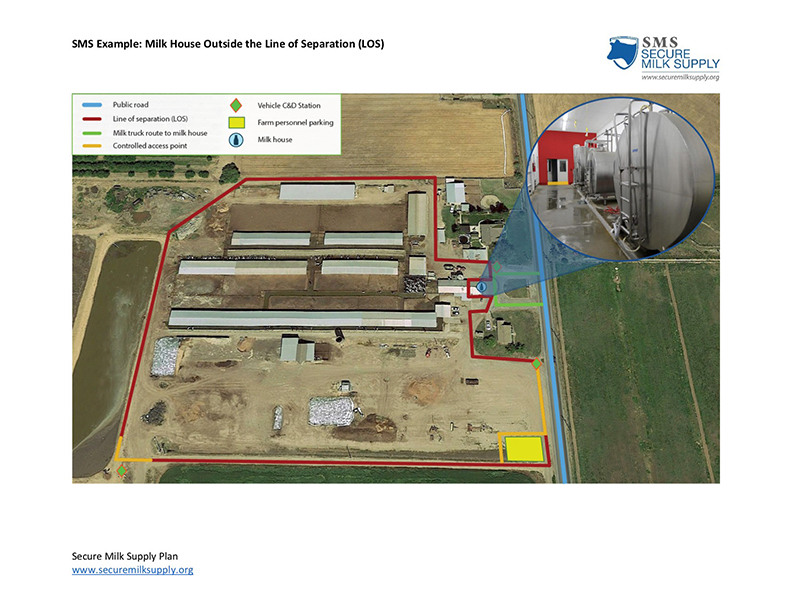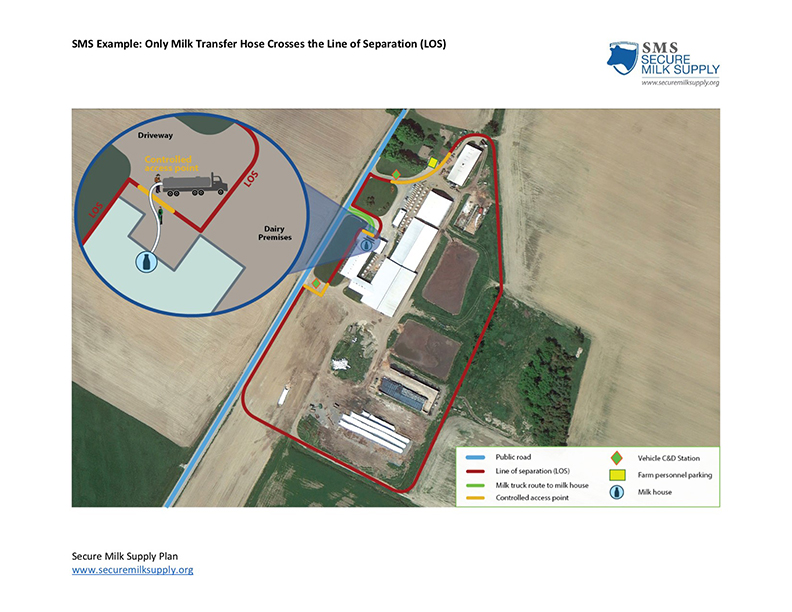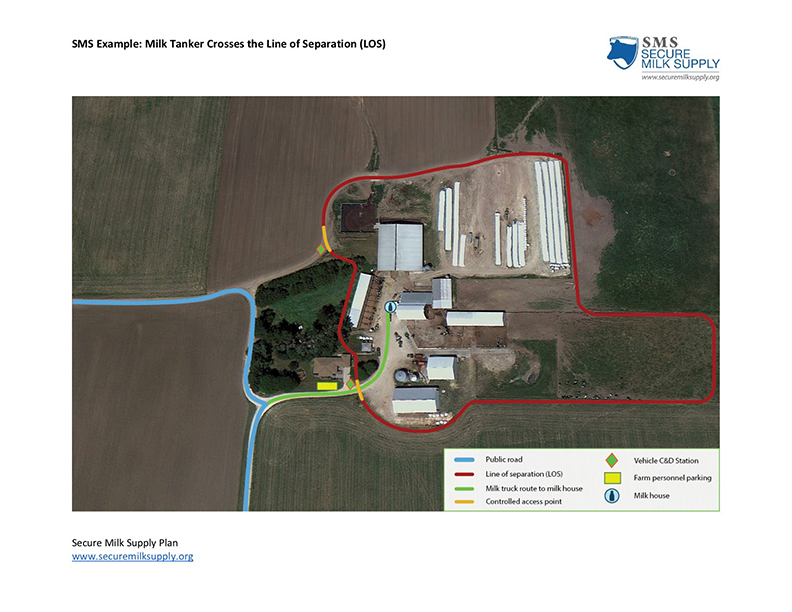Line of Separation: Definition
The Line of Separation (LOS) is an outer control boundary around a dairy premises. It serves as a way to limit the spread of virus into areas where susceptible animals can be exposed limiting access by off-farm traffic, such as the milk truck, from the on-farm movement of vehicles, people, and animals. The biosecurity plan clearly defines the farm's LOS and the LOS is clearly marked on the premises. Off-farm vehicles, such as the milk truck, would only enter onto the farm by crossing the LOS through a clearly marked and controlled LOS Access Point, after following appropriate biosecurity measures.
Summary of LOS options
For dairy premises, there are three general LOS layouts for milk collection from farms. The table on the following page summarizes each of these options. Each dairy farm is unique and the dairy farmer/Biosecurity Manager chooses the option that best fits the farm’s lay-out to create a plan for the operation. The milk collection procedure and biosecurity performance standards (BPS) for the milk truck, hauler, and dairy personnel will depend on the LOS scenario selected for the farm.
| LOS Option | Summary | Suitability | Tanker and Hauler |
|---|---|---|---|
| Milk house outside LOS |
|
|
|
| Only transfer hose crosses LOS |
|
|
|
| Milk truck and hauler cross LOS |
|
|
|
C&D = cleaning and disinfection; PPE = personal protective equipment
LOS Option 1: Milk House Outside LOS
- The farm establishes LOS so that the milk house is outside the LOS.
- The milk truck will not have to cross the LOS to pick up milk.
- C&D of the tanker is not be required, and the hauler exits the truck and goes into the milk house to performs all milk collection activities.
- Following milk collection activities, dairy farm personnel C&D the milk house to reduce the risk that farm personnel entering the milk house will come in contact with any potentially infected materials accidentally brought on site by the hauler. After C&D of the milk house, it is safe for farm personnel to enter and continue with cleaning and other activities. The interior of milk house now returns to being considered within the LOS.
- Dairy premises that utilize direct load or single load tankers may have a farm layout conducive to this approach.
- This option closely aligns with normal milk collection activities in a non-FMD outbreak situation.
- This method reduces the challenges faced due to inclement weather (strong wind, heavy rains causing mud, heavy snow, freezing temperatures, etc.) as well as challenges for premises faced with water shortages.
Suitability Checklist:
- Milk house is adjacent to a public road and tanker does not enter dairy premises to collect milk. – OR –
- Drive path leading to the milk house does not pass close to susceptible animals – AND –
- Drive path leading to milk house is not shared with vehicles that are used on-farm in animal areas.
- Area in front of the milk house does not slope towards animal housing or holding areas.
- The hauler/driver is trained in proper protective gear donning, doffing, and disposal.
- Doors leading from the milk house can be established as controlled access points with signage, proper biosecurity steps posted, and all supplies required to meet the biosecurity steps.
- Dairy premises personnel are trained in proper C&D protocols for the milk house.
- Dairy premises personnel are trained in proper protective gear donning, doffing, and disposal.

In this example satellite photo of a large dairy farm, a red line is drawn to show the line of separation around the farm, an orange line indicates the LOS access points, and a green diamond represents the location of the vehicle cleaning and disinfection station. A green line shows the milk truck path to the milk house, which is located near the east edge of the premises and represented by a blue circle containing a milk bottle icon. A yellow rectangle indicates the farm personnel parking area, and a blue line indicates a public road next to the east side of the dairy. An insert photo shows the bulk milk tanks inside the milk house.
LOS Option 2: Only Transfer Hose Crosses LOS
- The farm establishes the area just in front of the milk house as outside the LOS. The LOS runs just in front of the milk house, leaving an area for the milk truck to get close enough to connect the transfer hose to the bulk tank.
- The area where the milk tanker parks near the milk house is outside the LOS, and C&D of the tanker is not required.
- The hauler/driver works with farm personnel to accomplish milk collection activities, each staying on their respective side of the LOS.
- To prevent FMD introduction to the herd, the transfer hose exterior must have no visible contamination as it crosses the LOS.
- To prevent FMD spread, residual raw milk in a truck-mounted transfer hose must not be deposited on subsequent dairy premises.
- Dairy farm personnel assist with milk collection performing some of the duties usually performed by the hauler such as agitating the milk, connecting and disconnecting the transfer hose, and collection samples.
Suitability Checklist:
- Milk house is adjacent to a public road and tanker does not enter dairy premises to collect milk. – OR –
- Drive path leading to the milk house does not pass close to susceptible animals – AND –
- Drive path leading to milk house is not shared with vehicles that are used on-farm in animal areas.
- Area in front of the milk house does not slope towards animal housing or holding areas.
- State requirements for a licensed weigher/sampler on-farm to perform milk collection duties can be met. AND Dairy premises personnel are licensed/trained in collection of bulk tank milk samples.
- A transfer hose is available that is long enough to reach from the bulk tank to the milk tanker through a controlled access point and does not exceed pump manufacturer's recommendations.
- The hauler/driver can work with farm personnel to accomplish milk collection activities.
- The hauler/driver is trained in proper protective gear donning, doffing, and disposal.
- Dairy premises personnel are trained in proper C&D protocols for the milk transfer hose.
- Dairy premises personnel are trained in proper protective gear donning, doffing, and disposal.

In this example satellite photo of another, slightly smaller dairy farm, a red line is again drawn to show the line of separation around the farm, an orange line indicates the LOS access points, and a green diamond represents the location of the vehicle cleaning and disinfection station. A green line shows the milk truck path to the milk house, which is located near the west edge of the premises and represented by a blue circle containing a milk bottle icon. A yellow rectangle indicates the farm personnel parking area, and a blue line indicates a public road along the west side of the dairy. An inset schematic shows a close-up of the transfer hose crossing the LOS to the milk house, with the hauler on one side of the LOS and the producer on the other side.
LOS Option 3: Milk Truck/Tanker and Hauler/Driver Cross LOS
- The milk truck/tanker drive path passes near animal housing or holding areas, so the LOS must be established at some distance from these animals to protect them from possible exposure.
- The dairy premises has a C&D station set up outside of, but adjacent to, the controlled access point in order to C&D all milk trucks/tankers entering and leaving the farm.
- The milk truck/tanker undergoes C&D prior to crossing the LOS at the controlled access point.
- Milk hauler/driver exiting the cab to collect milk does not contact people, animals, or milk fed to susceptible animals, and wears proper PPE.
- Truck-mounted transfer hose is handled to prevent depositing raw milk and environmental contamination from previous farm pickups onto the dairy premises.
- Another option: Use a farm-dedicated transfer hose.
Suitability Checklist:
- Drive path leading to the milk house passes close to susceptible animals – AND/OR –
- Drive path leading to milk house is shared with vehicles that are used on-farm in animal areas – AND/OR –
- Area in front of the milk house slopes towards animal housing or holding areas.

In this example satellite photo of a smaller dairy farm, a red line is drawn to show the line of separation around the farm, an orange line indicates the LOS access points, and a green diamond represents the location of the vehicle cleaning and disinfection station. A green line shows the milk truck path to the milk house, which is located more centrally within the dairy buildings and represented by a blue circle containing a milk bottle icon. A yellow rectangle indicates the farm personnel parking area, and a blue line indicates a public road next to the southwest side of the dairy.

